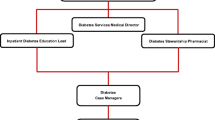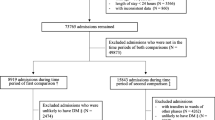Abstract
The management of inpatient hyperglycemia is a focus of quality improvement projects across many hospital systems while remaining a point of controversy among clinicians. The association of inpatient hyperglycemia with suboptimal hospital outcomes is accepted by clinical care teams; however, the clear benefits of targeting hyperglycemia as a mechanism to improve hospital outcomes remain contentious. Glycemic management is also frequently confused with efforts aimed at intensive glucose control, further adding to the confusion. Nonetheless, several regulatory agencies assign quality rankings based on attaining specified glycemic targets for selected groups of patients (Surgical Care Improvement Project (SCIP) measures). The current paper reviews the data supporting the benefits associated with inpatient glycemic control projects, the components of a successful glycemic control intervention, and utilization of the electronic medical record in implementing an inpatient glycemic control project.

Similar content being viewed by others
References
Papers of particular interest, published recently, have been highlighted as: • Of importance •• Of major importance
Inzucchi SE. Clinical practice. Management of hyperglycemia in the hospital setting. N Engl J Med. 2006;355(18):1903–11.
Moghissi ES, Korytkowski MT, DiNardo M, Einhorn D, Hellman R, Hirsch IB, et al. American Association of Clinical Endocrinologists and American Diabetes Association consensus statement on inpatient glycemic control. Diabetes Care. 2009;32(6):1119–31. doi:10.2337/dc09-9029.
Kosiborod M, Inzucchi SE, Krumholz HM, Xiao L, Jones PG, Fiske S, et al. Glucometrics in patients hospitalized with acute myocardial infarction: defining the optimal outcomes-based measure of risk. Circulation. 2008;117(8):1018–27. doi:10.1161/CIRCULATIONAHA.107.740498.
Munoz M, Pronovost P, Dintzis J, Kemmerer T, Wang NY, Chang YT, et al. Implementing and evaluating a multicomponent inpatient diabetes management program: putting research into practice. Jt Comm J Qual Patient Saf. 2012;38(5):195–206. Practical compendium of the elements for constructing a glycemic control committee.
Lleva RR, Thomas P, Bozzo JE, Hendrickson KC, Inzucchi SE. Using the glucometrics website to benchmark ICU glucose control before and after the NICE-SUGAR study. J Diabetes Sci Technol. 2014;8(5):918–22. doi:10.1177/1932296814540871. Benchmark national data through the Yale Glucometrics™ website.
Foster JJ, Pitts W. Implementation of an insulin therapy protocol: applying the Baldrige approach. Am J Health Syst Pharm. 2009;66(11):1035–8. doi:10.2146/ajhp080451.
McIver FB, Mitchell CA, Finn CP, Kamp MC. Standardising practices through form design and education improves insulin management. Aust Health Rev. 2009;33(3):434–41.
Maynard G, Schnipper JL, Messler J, Ramos P, Kulasa K, Nolan A, Rogers K. Design and implementation of a web-based reporting and benchmarking center for inpatient glucometrics. J Diabetes Sci Technol. 2014. Society of Hospital Medicine designed and implemented web-based data reporting.
Lahue BJ, Pyenson B, Iwasaki K, Blumen HE, Forray S, Rothschild JM. National burden of preventable adverse drug events associated with inpatient injectable medications: healthcare and medical professional liability costs. Am Health Drug Benefit. 2012;5(7):1–10.
Roberts GW, Aguilar-Loza N, Esterman A, Burt MG, Stranks SN. Basal-bolus insulin versus sliding-scale insulin for inpatient glycaemic control: a clinical practice comparison. Med J Aust. 2012;196(4):266–9.
Umpierrez GE, Palacio A, Smiley D. Sliding scale insulin use: myth or insanity? Am J Med. 2007;120(7):563–7.
Lansang MC, Modic MB, Sauvey R, Lock P, Ross D, Combs P, et al. Approach to the adult hospitalized patient on an insulin pump. J Hosp Med. 2013;8(12):721–7. doi:10.1002/jhm.2109.
Cobaugh DJ, Maynard G, Cooper L, Kienle PC, Vigersky R, Childers D, et al. Enhancing insulin-use safety in hospitals: practical recommendations from an ASHP Foundation expert consensus panel. Am J Health Syst Pharm. 2013;70(16):1404–13. doi:10.2146/ajhp130169.
Herring R, Pengilley C, Hopkins H, Tuthill B, Patel N, Nelson C, et al. Can an interprofessional education tool improve healthcare professional confidence, knowledge and quality of inpatient diabetes care: a pilot study? Diabet Med. 2013;30(7):864–70. doi:10.1111/dme.12153.
Taylor CG, Morris C, Rayman G. An interactive 1-h educational programme for junior doctors, increases their confidence and improves inpatient diabetes care. Diabet Med. 2012;29(12):1574–8. doi:10.1111/j.1464-5491.2012.03688.x.
Schnipper JL, Ndumele CD, Liang CL, Pendergrass ML. Effects of a subcutaneous insulin protocol, clinical education, and computerized order set on the quality of inpatient management of hyperglycemia: results of a clinical trial. J Hosp Med. 2009;4(1):16–27. doi:10.1002/jhm.385. Integration of insulin protocols with computer based order entry.
Tamler R, Dunn AS, Green DE, Skamagas M, Breen TL, Looker HC, et al. Effect of online diabetes training for hospitalists on inpatient glycaemia. Diabet Med. 2013;30(8):994–8. doi:10.1111/dme.12151.
Tamler R, Green DE, Skamagas M, Breen TL, Lu K, Looker HC, et al. Durability of the effect of online diabetes training for medical residents on knowledge, confidence, and inpatient glycemia. J Diabetes. 2012;4(3):281–90. doi:10.1111/j.1753-0407.2012.00189.x.
Tamler R, Green DE, Skamagas M, Breen TL, Looker HC, Babyatsky M, et al. Effect of case-based training for medical residents on inpatient glycemia. Diabetes Care. 2011;34(8):1738–40. doi:10.2337/dc11-0517.
Destree L, Ludwig-Beymer P, Vercellino M, Rowe A. Effects of education on nurse confidence and cardiac surgical glycemic control. AACN Adv Crit Care. 2013;24(4):362–9. doi:10.1097/NCI.0b013e31829c1dbe.
Yu CH, Sun XH, Nisenbaum R, Halapy H. Insulin order sets improve glycemic control and processes of care. Am J Med. 2012;125(9):922–8.e4. doi:10.1016/j.amjmed.2012.02.018.
Kennihan M, Zohra T, Devi R, Srinivasan C, Diaz J, Howard BS, et al. Individualization through standardization: electronic orders for subcutaneous insulin in the hospital. Endocr Pract. 2012;18(6):976–87. doi:10.4158/EP12107.RA.
Rattan R, Nasraway SA. The future is now: software-guided intensive insulin therapy in the critically ill. J Diabetes Sci Technol. 2013;7(2):548–54.
Davidson PC, Steed RD, Bode BW. Glucommander: a computer-directed intravenous insulin system shown to be safe, simple, and effective in 120,618 h of operation. Diabetes Care. 2005;28(10):2418–23.
Newton CA, Smiley D, Bode BW, Kitabchi AE, Davidson PC, Jacobs S, et al. A comparison study of continuous insulin infusion protocols in the medical intensive care unit: computer-guided vs. standard column-based algorithms. J Hosp Med. 2010;5(8):432–7. doi:10.1002/jhm.816. Computer based insulin dosing algorithms are superior in obtaining lower mean glucose compared to standard insulin infusion orders.
Davidson PC, Steed RD, Bode BW, Hebblewhite HR, Prevosti L, Cheekati V. Use of a computerized intravenous insulin algorithm within a nurse-directed protocol for patients undergoing cardiovascular surgery. J Diabetes Sci Technol. 2008;2(3):369–75.
Yamashita S, Ng E, Brommecker F, Silverberg J, Adhikari NK. Implementation of the glucommander method of adjusting insulin infusions in critically ill patients. Can J Hosp Pharm. 2011;64(5):333–9.
Saager L, Collins GL, Burnside B, Tymkew H, Zhang L, Jacobsohn E, et al. A randomized study in diabetic patients undergoing cardiac surgery comparing computer-guided glucose management with a standard sliding scale protocol. J Cardiothorac Vasc Anesth. 2008;22(3):377–82. doi:10.1053/j.jvca.2007.09.013.
Juneja R, Roudebush C, Kumar N, Macy A, Golas A, Wall D, et al. Utilization of a computerized intravenous insulin infusion program to control blood glucose in the intensive care unit. Diabetes Technol Ther. 2007;9(3):232–40.
Aloi J, McFarland R, Chidester P. Sentara health system sees reduction in hypoglycemia across 9 hospitals in first 30 days using inpatient glycemic management system by Glytec. Diabetes. 2014;63 suppl 1:A565. abstract.
McFarland R, Chidester P, Aloi J, Conner S, Schriever S. Sentara health system prepares for VBP measure changes with SCIP Inf-4 by turning to patient centric IV insulin dosing software. Diabetes. 2014;63 suppl 1:A620. abstract.
Hara JS, Rahbar AJ, Jeffres MN, Izuora KE. Impact of a hyperglycemic crises protocol. Endocr Pract. 2013;19(6):953–62. doi:10.4158/EP13077.OR.
Weeks DL, Keeney BJ, Evans PC, Moore QD, Conrad DA. Provider perceptions of the electronic health record incentive programs: a survey of eligible professionals who have and have not attested to meaningful use. J Gen Intern Med. 2015;30(1):123–30.
Boaz M, Landau Z, Matas Z, Wainstein J. Institutional blood glucose monitoring system for hospitalized patients: an integral component of the inpatient glucose control program. J Diabetes Sci Technol. 2009;3(5):1168–74.
Anderson M, Zito D, Kongable G. Benchmarking glucose results through automation: the 2009 remote automated laboratory system report. J Diabetes Sci Technol. 2010;4(6):1507–13.
Boaz M, Landau Z, Wainstein J. Analysis of institutional blood glucose surveillance. J Diabetes Sci Technol. 2010;4(6):1514–5.
Goldberg PA, Bozzo JE, Thomas PG, Mesmer MM, Sakharova OV, Radford MJ, et al. “Glucometrics”—assessing the quality of inpatient glucose management. Diabetes Technol Ther. 2006;8(5):560–9.
Compliance with Ethics Guidelines
Conflict of Interest
Joseph A. Aloi, Christopher Mulla, Jagdeesh Ullal, and David C. Lieb declare that they have no conflict of interest.
Human and Animal Rights and Informed Consent
This article does not contain any studies with human or animal subjects performed by any of the authors.
Author information
Authors and Affiliations
Corresponding author
Additional information
This article is part of the Topical Collection on Hospital Management of Diabetes
Rights and permissions
About this article
Cite this article
Aloi, J.A., Mulla, C., Ullal, J. et al. Improvement in Inpatient Glycemic Care: Pathways to Quality. Curr Diab Rep 15, 18 (2015). https://doi.org/10.1007/s11892-015-0587-4
Published:
DOI: https://doi.org/10.1007/s11892-015-0587-4




